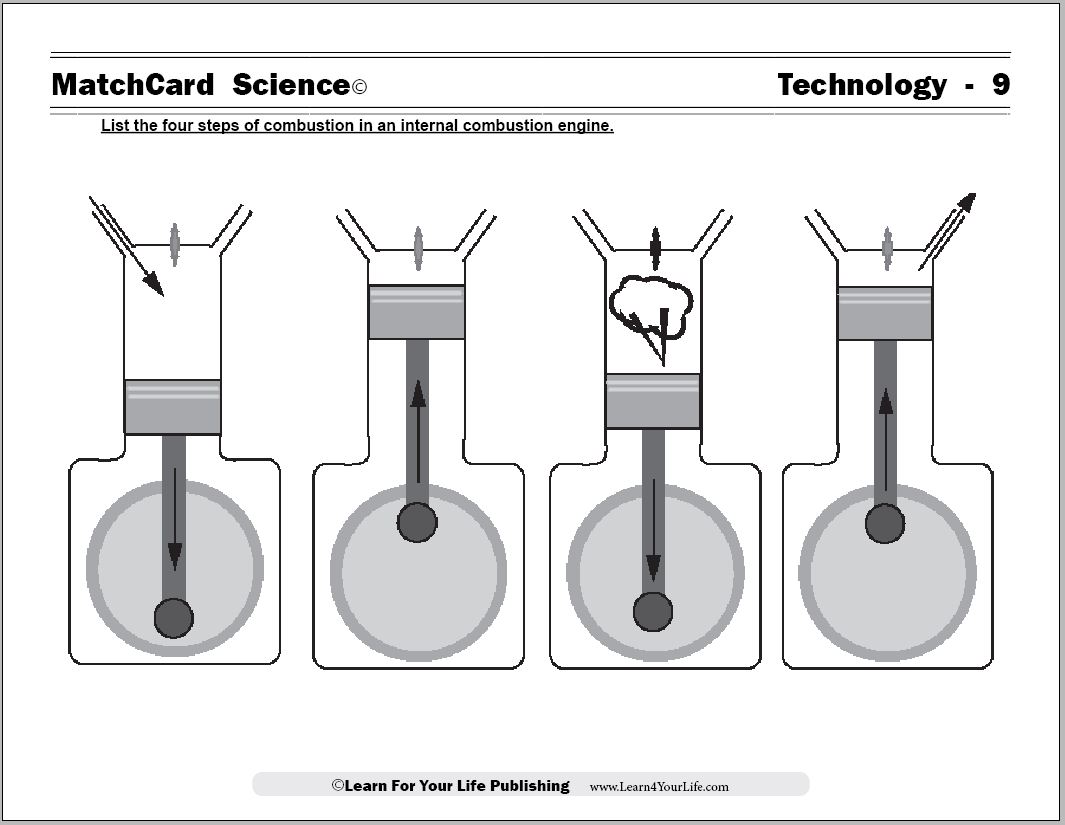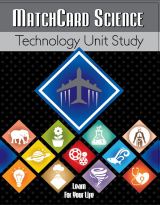Internal Combustion Enginge Lesson
This lesson and MatchCard teach the technology of Internal Combustion EnginesFree Download Below


MatchCard Science Electronic Worksheet
Objective: List the four steps of combustion in an internal combustion engine.MatchCard: Download below.
MatchCard Information Pieces define and describe minerals and rocks. Ideas for projects are listed on the instructor's page and below.
Print the Internal Combustion Engine MatchCard


Click image to go to download.
This is MatchCard #9 of the Technology Unit Study. Find more information on MatchCard Science below.
Introducting Internal Combustion Engines
Get Started with Your Lesson
Questions to ask:- What’s the difference between a motor and an engine?
- What is a motor or an engine?
- Why do we put gasoline in the car?
- How would you like an EXACT scientific definition of motor and engine?
What is a Motor
Motor comes from the Latin word to move. It’s pretty easy to understand where we got that term, isn’t it?Today we refer to a motor as a device which is powdered by one form of energy and converts it to motion. (Remember the conservation of energy from the Light & Energy Unit Study?)
What Is An Engine?
Engine comes from the same word as ingenius or ingenuity. In antiquity the term was applied to “engines of war” or catapaults. In the Middle Ages they developed engines of torture. Not too ingenius, huh?Today we refer to an engine as a motor that burns fuel in order to produce mobility (or kinetic energy.)
Gasoline & Engines
So what do we use the gasoline for? We burn it in an engine which converts the heat energy into kinetic energy.What Is An Internal Combustion Engine
Cars and trucks use internal combustion engines. You probably can figure out what this means:- internal: inside the car
- combustion: burning fuel in the presence of oxygen
- engine: converts heat energy into motion
Combustion of Gasoline
So what would happen if you lit a match and threw it in a barrel of gasoline.KaBoom
Not only would you get killed, you would also cause an explosion that could take down a block of houses. Very bad idea.Butane
But instead of gasoline, you can burn butane from a butane lighter. When you strike it open, a small spark lights the butane which then burns in the presence of oxygen.2C4H10 + 13O2 → 8 CO2 + 10H2O
Propane
If you have a propane grill, the same thing happens. You need the propane fuel, the oxygen, and the spark to cause the fuel to burn.C3H8 + 5O2 → 3 CO2 + 4H2O
Gasoline
And while we don’t want you to burn gasoline, here’s the chemical equation:C8H18 + 25 O2 → 16 CO2 + 18 H2O
Flour Combustion
A Little Combustion Demo that Dangerous
Okay, you know all the times we say “adult supervision necessary” whenever a kid uses a stove, a knife, or scissor? (Like we don’t know that kids use them all the time on their own.) Well, this time we MEAN it! This is an adult only experiment and best if the adult does it. Moreover, you really should have safety goggles AND if you have long frizzy hair wrap it up out of the way (hair burns really, really fast.)No, we are not going to blow up a keg of gasoline: just a little flour or cornstarch. Huh, you don’t believe it’s flammable? Well, sometimes people who do the firebreathing stunts at shows are using something like cornstarch that they blow over an open flame - and voiola! Fire!
Unless you are a professional stuntman you should wear goggles and use a drinking straw to keep the fire away from your face.
- Put on safety glasses
- Light a small candle (the bigger the flame the bigger the combustion)
- Sprinkle some flour or cornstarch down a drinking straw.
- Put the straw in your mouth and lightly blow so the powder shoots out of the straw right over the flame (do not aim toward the flame or you will blow the flame out.)
- You will see a little combustion (burning) of the flour or cornstarch.
Combustion in Your Car
Four Stages of Internal Combustion
So now let’s look at how the combustion reactions make your car run. We are going to look at the Answer Key to the MatchCard. You see four different diagrams of an engine as it goes throught he four phases of the combustion cycle. The circle at the bottom is the crankshaft. As it spins it moves the piston up and down in the tube. Look at the four pics and notice how the piston goes up and down: that’s it’s entire job.Intake Stroke
With the intake stroke, the piston is moving downward. That allows the gasoline and air to move into the engine as the arrow shows. It’s the same principle as inhalation: when you inhale the diaphragm moves downward and air moves in to fill the empty space.But this is more than just air. It is air AND fuel (gasoline.) What did our little flour demonstration show us? Answer: combustion requires oxygen molecules surrounding the fuel.
Compression Stroke
Look what happens when the crankshaft turns. The piston moves up. The valves at the top are closed off and the air and fuel are compressed (pressed together.) Makes sense they call it the compression stroke.Combustion Stroke
Here comes the fun. See the spark plug at the top of the engine casing? Guess what it does. Yep, it sparks, just like the spark on a butane lighter. And all that compressed fuel and oxygen. You got it, a little boom. That pushes the piston downward.Exhaust Stroke
No stopping just because a little explosion happened; the engine keeps working and the piston is coming back up. The exhaust valve opens and the waste products of the combustion reaction leave the engine. On your car, the exhaust will eventually exit from the exhaust pipe.Watch the Four Stroke Animation
It is much easier to visualize what is happening with an animated video. Check out youtube or other internet sites for an animation of the four stroke cycle. Here is the link to a Four Stroke Engine Animation in less than three minutes.Build Your Own Four Stroke Engine
Let’s take it a step further: don’t just watch it - build it!Here are a few kits in the $50 to $100 range that will allow your mechanical genius to get further aquanited with engines:
- Smithsonian MotorWorks - under $50
- Haynes Build Your Own Internal Combustion Engine - $50 to $100
- Revell 12 inch Plastic Model Engine -- about $50
MatchCard Science
How To Use MatchCards

Download the FREE MatchCard Science Instructor's Guide and see how MatchCards can make building their science knowledge base fun.
12 Science Unit Studies

Chemistry is only one of twelve complete unit studies for kids in 3rd to 8th grade.
Comprehensive objectives, hands-on projects, suggested science fair experiments, and the fun game-like MatchCards keep them interested in learning science. See all twelve MatchCard Science Unit Studies.
About Our Site
Hands-On Learning














